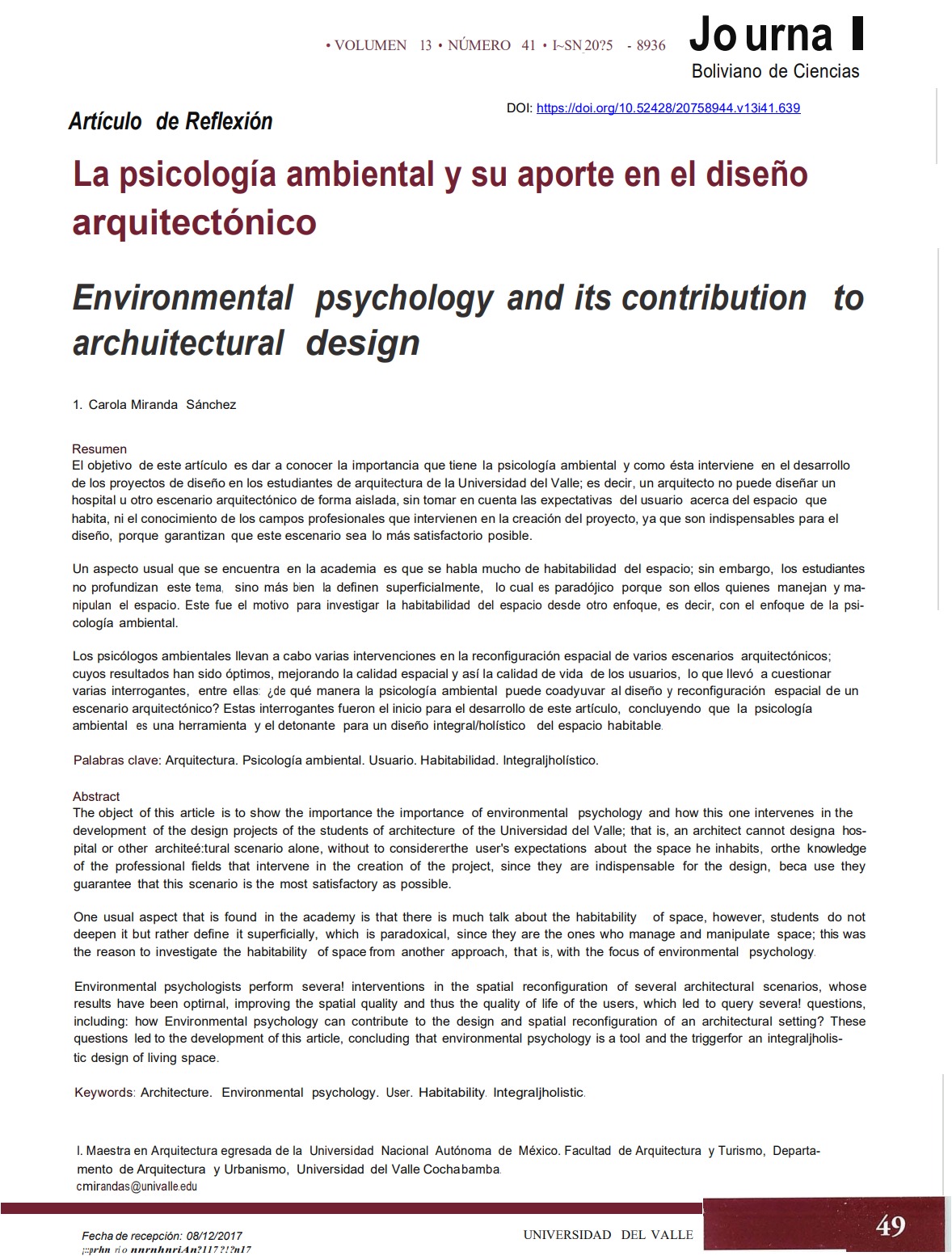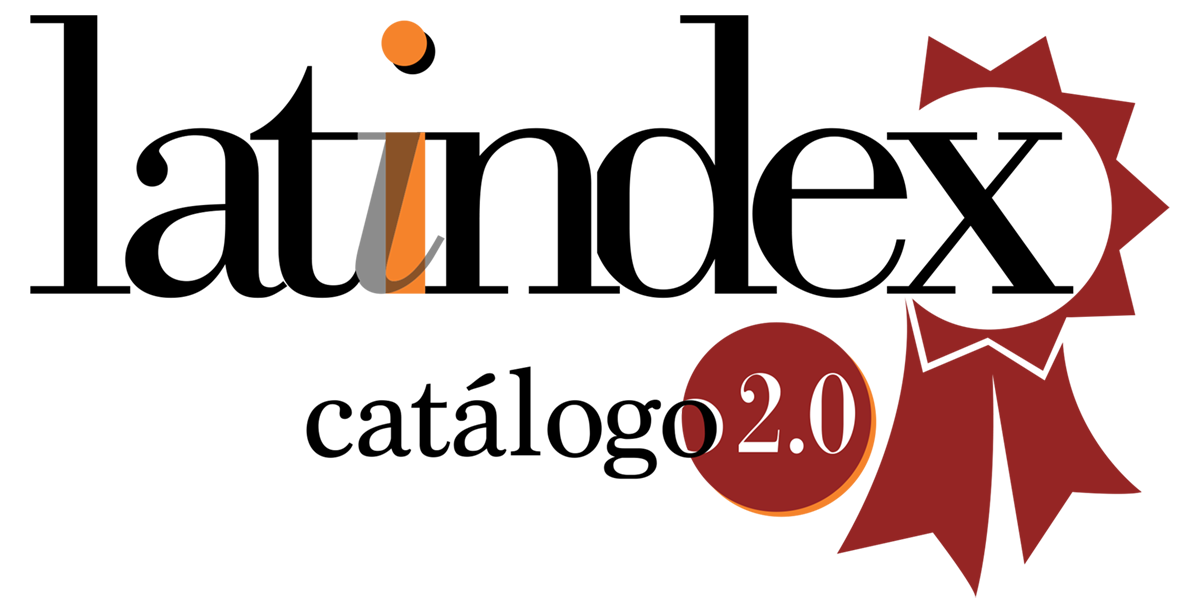Environmental Psychology and its Contribution to Archuitectural Design
DOI:
https://doi.org/10.52428/20758944.v13i41.639Keywords:
Architecture, Environmental Psychology, User, Habitability, lntegral/Holistic.Abstract
El objetivo de este artículo es dar a conocer la importancia que tiene la psicología ambiental y como ésta interviene en el desarrollo de los proyectos de diseño en los estudiantes de arquitectura de la Universidad del Valle; es decir, un arquitecto no puede diseñar un hospital u otro escenario arquitectónico de forma aislada, sin tomar en cuenta las expectativas del usuario acerca del espacio que habita, ni el conocimiento de los campos profesionales que intervienen en la creación del proyecto, ya que son indispensables para el diseño, porque garantizan que este escenario sea lo más satisfactorio posible. Un aspecto usual que se encuentra en la academia es que se habla mucho de habitabilidad del espacio; sin embargo, los estudiantes no profundizan este tema, sino más bien la definen superficialmente, lo cual es paradójico porque son ellos quienes manejan y manipulan el espacio. Este fue el motivo para investigar la habitabilidad del espacio desde otro enfoque, es decir, con el enfoque de la psicología ambiental. Los psicólogos ambientales llevan a cabo varias intervenciones en la reconfiguración espacial de varios escenarios arquitectónicos, cuyos resultados han sido óptimos, mejorando la calidad espacial y así la calidad de vida de los usuarios, lo que llevó a cuestionar varias interrogantes, entre ellas: ¿de qué manera la psicología ambiental puede coadyuvar al diseño y reconfiguración espacial de un escenario arquitectónico? Estas interrogantes fueron el inicio para el desarrollo de este artículo, concluyendo que la psicología ambiental es una herramienta y el detonante para un diseño integral/holístico del espacio habitable.
Downloads
References
(1) Vitruvio, P.M. (2009). Los diez libros de Arquitectura. "Vitruvio y la piel del clasicismo". Madrid: Editorial Alianza.
(2) Mansur, J. C. {1994). Conferencia de Heidegger: construir, habitar, pensar. Consultado el 9 de agosto de 2017 https://jcmansur.wordpress.com/estetica-y-ciudad/conferencia-de-heidegger-construir-pensar-habitar-bauen-denken-wohnen/
(3) Holahan, C. (2009). Psicología ambiental: un enfoque general. México. Ed. Limusa
(4) Proshansky, M. lttelson, W. y Rivlin, L. G. {1983). Psicología ambiental. El hombre y su entorno físico. México: Trillas.
(5) Saldarriaga, A. (1981):Habitabilidad. Colombia: Bogotá. Escala fondo editorial.
(6) Enciso, S. (2005). Citado en la Habitabilidad Urbana. Proyectos construidos por el ICT en Cali 1960-1991. Consultado en agosto 2017 http://docplayer.es/54199040-La-habitabilidad-urbana-proyectos-construidos-por-el-ict-en-cali. htm1
(7)Castro, E. {1995). En Castro, E. (1999). Habitabilidad, medio ambiente y ciudad. 2º Congreso Latinoamericano: El habitar. Una orientación para la investigación proyectual. México: Universidad Autónoma Metropolitana.
(8) Gómez, A. {2007). Propuesta de acerca de la filosofía de la Facultad de Arquitectura y Diseño. México: Universidad de Colima. México.
(9) Mercado, S., Ortega, P., Estrada, C. y Luna, M. (1995). Habitabilidad de la Vivienda Urbana. México: Universidad Nacional Autónoma de México.
(10) Pérez, A. (1999). La construcción de indicadores Bio-Ecológicos para medir la calidad del ambiente natural urbano. Documento de investigación del Grupo de Calidad Ambiental Urbana de la Facultad de Arquitectura y Arte de la Universidad de Los Andes, Mérida, Venezuela.
(11) Revollo, F. (2017). Complejo Hospitalario para la Ciudad de Cochabamba. Taller de arquitectura noveno del semestre 1/2017. Cochabamba: Universidad del Valle.
(12) Bustillo. F. (2017). Mercado Alejo Calatayud de la ciudad de Cocha bamba. Taller de arquitectura noveno del semestre 1/2017. Cochabamba: Universidad del Valle.
(13) Sanjinés, C. y López, l. (2017). Mercado Alejo Calatayud de la ciudad de Cochabamba. Taller de arquitectura noveno del semestre 1/2017. Cochabamba: Universidad del Valle.
(14) Delgado, B. y Failache, S. (1993). El concepto de Calidad de Vida: una revisión de su alcance y contenido. Venezuela: Revista Geográfica Venezolana. N°34.
(15) Miranda, S. C. (2014). Psicología ambiental & Arquitectura Hospitalaria: Diseño de ambientes restauradores enfocados al paciente geriátrico. Tesis de Maestría en Arquitectura. México: Universidad Nacional Autónoma de México (UNAM).
(16) Oporto {2017). Diseño Arquitectónico de la Biblioteca Municipal para Cochabamba-Municipio de Cercado. Cochabamba: Universidad del Valle.
(17) Ortega, P., Reidl, L., Lopez, E. y Estrada, C. (2001). Artículo: Evaluación ambiental del personal de un centro de atención especializado. Revista Psicología y Ciencia Social. México: Facultad de psicología, UNAM.
(18) Ortega, P., Mercado, S., Reidl, L. M. y Estrada, C. (2005). Estrés ambiental en instituciones de salud. México: D.F. Universidad Nacional Autónoma de México.
(19) Wohlwill, J. F. (1966). The Physical Environment: a problem for a psychology of stimulation. E E . U U . : Journal of Social lssues.

Downloads
Published
How to Cite
Issue
Section
License
Copyright (c) 2017 Carola Miranda Sánchez

This work is licensed under a Creative Commons Attribution 4.0 International License.
Authors who publish with this journal agree to the following terms:
- Authors retain copyright and grant the journal right of first publication with the work simultaneously licensed under a Creative Commons Attribution License 4.0 that allows others to share the work with an acknowledgement of the work's authorship and initial publication in this journal.
- Authors are able to enter into separate, additional contractual arrangements for the non-exclusive distribution of the journal's published version of the work (e.g., post it to an institutional repository or publish it in a book), with an acknowledgement of its initial publication in this journal.
- Authors are permitted and encouraged to post their work online (e.g., in institutional repositories or on their website) prior to and during the submission process, as it can lead to productive exchanges, as well as earlier and greater citation of published work.














